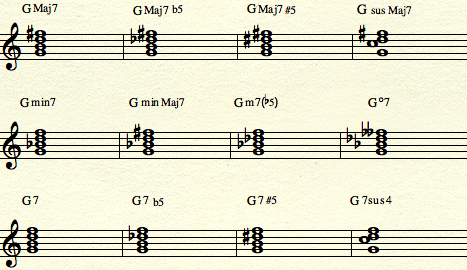In our first article of Fundamental Ear Training Exercises, we covered how to choose an ear training partner, the correct mindset to approach ear training with, and exercises about singing & hearing intervals, harmonic intervals, and triads.
After you feel you’ve got a pretty good handle on everything presented in that previous article, it’s time to explore seventh chords. The easiest way to approach this group of chords is by focusing on just root position chords that contain a root, a third, a fifth, and a seventh.
No ninths, elevenths, or thirteenths to worry about just yet. Look for that in the next part of this series. However, we will be making alterations to the 5th, which in a sense is making alterations to the 11th and 13th (b5 is equal to #11 and #5 is equal to b13. See my notes for major 7b5 chords about why the b5 can be different that the #11).
Since we’re only concerned with seventh chords in root position containing chord tones 1357, there are 12 seventh chords that we’re going to home in on:
- Major seventh, Major seventh b5, Major seventh +5, Sus major seventh
- Minor seventh, Minor major seventh, Half diminished seventh (aka minor seven flat five), Fully diminished seventh
- Dominant seventh, Dominant seventh b5, Dominant seventh +5, and Sus dominant seventh
Notes on each seventh chord
Go to the piano and play these 12 chords. Work on hearing the intricacies of each chord.
There are some little tricks I’ve picked up while practicing these that help me hear these chords. You’ll figure out your own tricks, but maybe these will help you hear the chords more quickly. Eventually you will hear each chord as a color and its interval content will fall to the background.
- Major seventh – Focus on hearing the character of the major seventh chord tone and notice the great depth & color this chord tone adds
- Major seventh b5 – Realize that this is where a “b5” sound is different than a “#11.” While technically the same note (in the case of G Major, Db or C#), they sound different because the b5 sound does not contain a natural 5th in the chord, whereas a #11 chord could. Play a G major seventh chord and throw a C# on top. Hear the difference? Also, in this chord, focus on hearing that whole step between the 3rd (B) and the b5 (Db), and the perfect fourth interval between the b5 (Db) and the major 7th (F#).
- Major seventh +5 – Hear the augmented triad (GBD#) and hear the minor third between the #5 (D#) and the 7th (F#)
- Sus major seventh – Hear the perfect fourth interval between the root and the sus4 and hear the major third between the 5th and 7th
- Minor seventh – Focus on hearing the character of the minor seventh in the chord and notice the color this chord tone adds
- Minor major seventh – Hear the major third between the 5th and the seventh
- Half Diminished Seventh (aka minor seven flat five) – Hear the diminished triad, 1 b3 b5, and hear the major third interval between the b5 (Db) and b7 (F)
- Fully diminished seventh – Listen for all minor third intervals
- Dominant seventh – Focus on hearing the character of the dominant seventh in the chord and notice the color this chord tone adds.
- Dominant seventh b5 – Hear the whole step between the 3rd (B) and the b5 (Db), and the major third interval between the b5 (Db) and the dominant 7th (F).
- Dominant seventh +5 – Hear the augmented triad (GBD#) and hear the whole step between the #5 (D#) and the dominant 7th (F)
- Sus dominant seventh – Hear the perfect fourth interval between the root and the sus4 and hear the minor third between the 5th (D) and dominant 7th (F)
Seventh chord ear training exercises
Once you get a feel for seventh chords and you practice them on your own for a while, grab your ear training partner and proceed through the following exercises. If you don’t have someone to practice ear training with, no worries, just play the chords and work through the exercises slowly on your own, aiming to sing and hear every chord perfectly.
Basic identification of each seventh chord and sing the bass
In this exercise you’ll practice identifying each chord and singing the bass note.
Partner
Plays a seventh chord from the list above.
You
Hear the chord in your mind. Sing the bass note and identify the chord. If you need it repeated before attempting to sing the bass note and identify it, request that your partner plays again.
Partner
Verifies pitch accuracy of your singing and whether you identified the chord correctly. If you are incorrect, have your partner play it again, listen even more closely and try again. Do not proceed to the next chord until you sing the bass note accurately and identify it correctly.
Repeat this process until your partner has randomly played all 12 seventh chords several times each.
Identify and sing each chord tone
Once you can clearly hear and sing the bass note, try singing up and down the chord.
Partner
Plays a seventh chord from the list above.
You
Hear the chord in your mind. Sing the bass note and then the 3rd, followed by the 5th, and finally the 7th. Then descend and sing the 7th, 5th, 3rd, and root. After you accurately sing each pitch in the chord, identify the chord. If you need it repeated before attempting to sing it or identify it, request that your partner plays again.
Partner
Verifies pitch accuracy of your singing and whether you identified the chord correctly. If you are incorrect, have your partner play it again, listen even more closely and try again. Do not proceed to the next chord until you sing it accurately and identify it correctly.
Repeat this process until your partner has randomly played all 12 seventh chords several times each.
Sing a specific chord tone in the seventh chord
After singing each note of the chords, learn to pick out specific chord tones.
Partner
Plays a seventh chord from the list above and specifies one of the chord tones.
You
Hear the chord in your mind and isolate the chord tone that your partner specified. Sing that specific chord tone paying close attention to how it sounds, then identify the chord. If you need it repeated before attempting to sing it, request that your partner play the chord again.
Partner
Verifies pitch accuracy of your singing. If you are incorrect, have your partner play it again, listen even more closely and try again. Do not proceed to the next chord until you sing and identify it accurately.
Repeat this process with another seventh chord.
Fundamental ear training: seventh chords
Accurately singing and hearing seventh chords comes from having built a strong foundation by practicing intervals and triads as described in these Fundamental Ear Training Exercises. The seventh chord exercises described in this article will continue to develop a strong foundation, paving the way to hear more and more complex sounds in the future.
Determine where you’re at in regards to developing your ear, and when appropriate, add these seventh chord exercises to your routine. Take your time and integrate them gradually into your practice. Aim to practice daily for 20 minutes. If you don’t have 20 minutes, find 10. Enjoy your daily ear training sessions and soon you’ll be hearing music in a totally different way than you do now.











